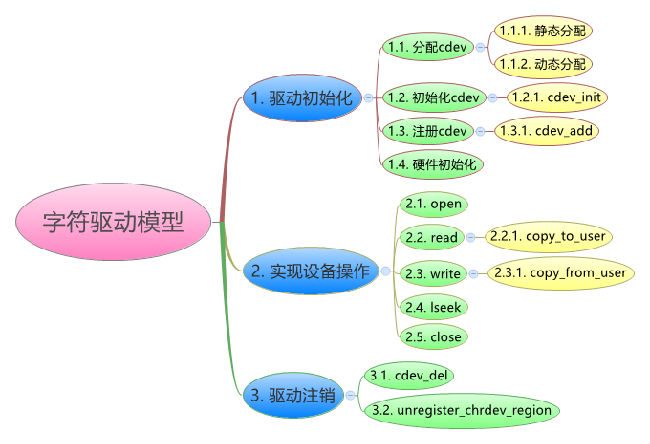看完宋宝华的《Linux设备驱动开发详解》及其有关博客,对字符设备驱动做一个小总结。
一、字符设备、字符设备驱动与用户空间访问该设备的程序三者之间的关系。

如图,在Linux内核中使用cdev结构体来描述字符设备,通过其成员dev_t来定义设备号(分为主、次设备号)以确定字符设备的唯一性。通过其成员file_operations来定义字符设备驱动提供给VFS的接口函数,如常见的open()、read()、write()等。
在Linux字符设备驱动中,模块加载函数通过register_chrdev_region( ) 或alloc_chrdev_region( )来静态或者动态获取设备号,通过cdev_init( )建立cdev与file_operations之间的连接,通过cdev_add( )向系统添加一个cdev以完成注册。模块卸载函数通过cdev_del( )来注销cdev,通过unregister_chrdev_region( )来释放设备号。
用户空间访问该设备的程序通过Linux系统调用,如open( )、read( )、write( ),来“调用”file_operations来定义字符设备驱动提供给VFS的接口函数。
二、字符设备驱动模型

(PS:神马情况!本地上传的图片,质量下降这么多)
1. 驱动初始化
1.1. 分配cdev
在2.6的内核中使用cdev结构体来描述字符设备,在驱动中分配cdev,主要是分配一个cdev结构体与申请设备号,以按键驱动为例:
08 | dev_id = MKDEV(major, 0); |
09 | register_chrdev_region(dev_id, 1, "button"); |
12 | alloc_chardev_region(&dev_id, 0, 1, "button"); |
13 | major = MAJOR(dev_id); |
从上面的代码可以看出,申请设备号有动静之分,其实设备号还有主次之分。
在Linux中以主设备号用来标识与设备文件相连的驱动程序。次编号被驱动程序用来辨别操作的是哪个设备。cdev 结构体的 dev_t 成员定义了设备号,为 32 位,其中高 12 位为主设备号,低20 位为次设备号。
设备号的获得与生成:
获得:主设备号:MAJOR(dev_t dev);
次设备号:MINOR(dev_t dev);
生成:MKDEV(int major,int minor);
设备号申请的动静之分:
静态:
1 | int register_chrdev_region(dev_t from, unsigned count, const char *name); |
静态申请相对较简单,但是一旦驱动被广泛使用,这个随机选定的主设备号可能会导致设备号冲突,而使驱动程序无法注册。
动态:
1 | int alloc_chrdev_region(dev_t *dev, unsigned baseminor, unsigned count,const char *name); |
动态申请简单,易于驱动推广,但是无法在安装驱动前创建设备文件(因为安装前还没有分配到主设备号)。
1.2. 初始化cdev
void cdev_init(struct cdev *, struct file_operations *);
cdev_init()函数用于初始化 cdev 的成员,并建立 cdev 和 file_operations 之间的连接。
1.3. 注册cdev
int cdev_add(struct cdev *, dev_t, unsigned);
cdev_add()函数向系统添加一个 cdev,完成字符设备的注册。
1.4. 硬件初始化
硬件初始化主要是硬件资源的申请与配置,以TQ210的按键驱动为例:
3 | gpio_request(S5PV210_GPH0(0), "GPH0_0"); |
5 | gpio_direction_input(S5PV210_GPH0(0)); |
2.实现设备操作
用户空间的程序以访问文件的形式访问字符设备,通常进行open、read、write、close等系统调用。而这些系统调用的最终落实则是file_operations结构体中成员函数,它们是字符设备驱动与内核的接口。以TQ210的按键驱动为例:
2 | static struct file_operations btn_fops = { |
5 | .release = button_close, |
上面代码中的button_open、button_close、button_read是要在驱动中自己实现的。file_operations结构体成员函数有很多个,下面就选几个常见的来展示:
2.1. open()函数
原型:
1 | int(*open)(struct inode *, struct file*); |
案例:
01 | static int button_open(struct inode *inode, struct file *file){ |
04 | struct button_priv *pbtnp = container_of(inode->i_cdev, |
08 | file->private_data = pbtnp; |
09 | if(down_interruptible(&pbtnp->sema)){ |
10 | printk("Proccess is INT!\n"); |
13 | printk("open button successfully !\n"); |
2.2. read( )函数
原型:
1 | ssize_t(*read)(struct file *, char __user*, size_t, loff_t*); |
案例:
01 | static ssize_t button_read(struct file *file, char __user *buf, |
02 | size_t count, loff_t *ppos){ |
04 | struct button_priv *pbtnp = file->private_data; |
06 | wait_event_interruptible(pbtnp->btn_wq, is_press != 0); |
09 | copy_to_user(buf, &key_value, sizeof(key_value)); |
2.3. write( )函数
原型:
1 | ssize_t(*write)(struct file *, const char__user *, size_t, loff_t*); |
案例:
01 | static ssize_t mem_write(struct file *filp, const char __user *buf, |
02 | size_t size, loff_t *ppos){ |
03 | unsigned long p = *ppos; |
04 | unsigned int count = size; |
06 | int *register_addr = filp->private_data; |
08 | if (p >= 5*sizeof(int)) |
10 | if (count > 5*sizeof(int) - p) |
11 | count = 5*sizeof(int) - p; |
13 | if (copy_from_user(register_addr + p, buf, count)) |
2.4. close( )函数
原型:
1 | int(*release)(struct inode *, struct file*); |
案例:
1 | static int button_close(struct inode *inode, struct file *file){ |
3 | struct button_priv *pbtnp = file->private_data; |
2.5. 补充说明
1. 在Linux字符设备驱动程序设计中,有3种非常重要的数据结构:struct file、struct inode、struct file_operations。
struct file 代表一个打开的文件。系统中每个打开的文件在内核空间都有一个关联的struct file。它由内核在打开文件时创建, 在文件关闭后释放。其成员loff_t f_pos 表示文件读写位置。
struct inode 用来记录文件的物理上的信息。因此,它和代表打开文件的file结构是不同的。一个文件可以对应多个file结构,但只有一个inode结构。其成员dev_t i_rdev表示设备号。
struct file_operations 一个函数指针的集合,定义能在设备上进行的操作。结构中的成员指向驱动中的函数,这些函数实现一个特别的操作, 对于不支持的操作保留为NULL。
2. 在read( )和write( )中的buff 参数是用户空间指针。因此,它不能被内核代码直接引用,因为用户空间指针在内核空间时可能根本是无效的——没有那个地址的映射。因此,内核提供了专门的函数用于访问用户空间的指针:
1 | unsigned long copy_from_user(void *to, const void __user *from, unsigned long count); |
2 | unsigned long copy_to_user(void __user *to, const void *from, unsigned long count); |
3. 驱动注销
3.1. 删除cdev
在字符设备驱动模块卸载函数中通过cdev_del()函数向系统删除一个cdev,完成字符设备的注销。
2 | void cdev_del(struct cdev *); |
3.2. 释放设备号
在调用cdev_del()函数从系统注销字符设备之后,unregister_chrdev_region()应该被调用以释放原先申请的设备号。
2 | void unregister_chrdev_region(dev_t from, unsigned count); |
4 | unregister_chrdev_region(MKDEV(major, 0), 1); |
三、Linux字符设备驱动模板与案例
1. 字符设备驱动模块加载与卸载函数模板
在实际开发中,通常习惯为设备定义一个设备相关的结构体,其包含该设备所涉及到的cdev、私有数据及信号量等信息。
11 | xxx_dev.cdev.owner = THIS_MODULE; |
14 | register_chrdev_region(xxx_dev_no, 1,DEV_NAME); |
16 | alloc_chrdev_region(&xxx_dev_no, 0, 1,DEV_NAME); |
18 | ret = cdev_add(&xxx_dev.cdev,xxx_dev_no, 1); |
23 | static void __exit xxx_exit(void) { |
24 | unregister_chrdev_region(xxx_dev_no, 1); |
25 | cdev_del(&xxx_dev.cdev); |
2.字符设备驱动读、写、IO控制函数模板
03 | ssize_t xxx_read(struct file *filp, char__user *buf, |
04 | size_t count,loff_t*f_pos) { |
06 | copy_to_user(buf, ..., ...); |
11 | ssize_t xxx_write(struct file *filp, const char__user *buf, |
12 | size_t count,loff_t*f_pos) { |
14 | copy_from_user(..., buf, ...); |
19 | int xxx_ioctl(struct inode *inode, struct file*filp, |
20 | unsigned int cmd, unsigned long arg) { |
在设备驱动的读、写函数中,filp是文件结构体指针,buf是用户空间内存的地址,该地址在内核空间不能直接读写,count 是要读的字节数,f_pos是读的位置相对于文件开头的偏移。
3.TQ210的最简单按键驱动示例
001 | #include <linux/init.d> |
002 | #include <linux/module.h> |
003 | #include <linux/cdev> |
004 | #include <linux/fs.h> |
005 | #include <linux/types.h> |
006 | #include <linux/uaccess.h> |
007 | #include <linux/device.h> |
009 | #include <plat/gpio-cfg.h> |
010 | #include <asm/gpio.h> |
014 | struct cdev btn_cdev; |
017 | static unsigned char key_value; |
021 | static ssize_t button_read(struct file *file, char __user *buf, |
022 | size_t count, loff_t *ppos) { |
026 | status = gpio_get_value(S5PV210_GPH0(0)); |
033 | copy_to_user(buf, &key_value, sizeof(key_value)); |
039 | static struct file_operations btn_fops = { |
040 | .owner = THIS_MODULE, |
045 | static struct class *btn_cls; |
048 | static init button_init(void){ |
053 | dev_id = MKDEV(major, 0); |
054 | register_chrdev_region(dev_id, 1, "button"); |
057 | alloc_chardev_region(&dev_id, 0, 1, "button"); |
058 | major = MAJOR(dev_id); |
062 | cdev_init(&btn_cdev, &btn_fops); |
065 | cdev_add(&btn_cdev, dev_id, 1); |
070 | btn_cls = class_create(THIS_MODULE, "button"); |
072 | device_create(btn_cls, NULL, dev_id, NULL, "button"); |
076 | gpio_request(S5PV210_GPH0(0), "GPH0_0"); |
078 | gpio_direction_input(S5PV210_GPH0(0)); |
086 | static void button_exit(void){ |
088 | gpio_free(S5PV210_GPH0(0)); |
091 | device_destroy(btn_cls, MKDEV(major, 0)); |
092 | class_destroy(btn_cls); |
098 | unregister_chrdev_region(MKDEV(major, 0), 1); |
101 | module_init(button_init); |
102 | module_exit(button_exit); |
103 | MODULE_LICENSE("GPL v2"); |
























 286
286

 被折叠的 条评论
为什么被折叠?
被折叠的 条评论
为什么被折叠?








